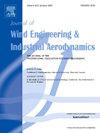道路车辆中由于大气波动引起的调制风噪声及减少措施
IF 4.9
2区 工程技术
Q1 ENGINEERING, CIVIL
Journal of Wind Engineering and Industrial Aerodynamics
Pub Date : 2025-08-22
DOI:10.1016/j.jweia.2025.106210
引用次数: 0
摘要
在汽车开发中,降噪是保证乘客舒适度的关键。随着电动汽车的普及以及发动机噪声和振动噪声的降低,车辆周围的空气动力噪声问题日益突出。特别是,由于大气乱流、阵风、前车的尾迹等引起的风噪声调节,会给乘客带来不适,因此成为一个问题。然而,对风噪声的调制没有明确的定义,对风噪声调制的机制也知之甚少。此外,调制风噪声的定量评价方法尚未建立,降噪措施也没有进展。这是因为以前的研究依赖于道路试验,由于大气条件的变化,这些试验无法重现。为了解决这个问题,汽车制造商正在开发通过在风洞中产生湍流来模拟自然风的设备。然而,这些方法无法模拟道路上的风况,因为自然风的大规模波动很难重现。在本研究中,我们模拟了道路上车辆所经历的波动风,并再现了调制风噪声。利用调制功率谱证实了风噪声调制可以定量评价,并研究了道路风分量对调制功率的贡献。进一步阐明了车辆周围流场对风噪声调制的机理。调变风噪声是由a柱纵向涡产生的1 kHz以上高频气动噪声,由于侧风的作用而变得突出,并被主流波动调幅的声学现象。抑制a柱分离可以降低风噪声调制功率峰值。本文章由计算机程序翻译,如有差异,请以英文原文为准。
Modulated wind noise in a road vehicle due to atmospheric fluctuations and reduction measures
In vehicle development, noise reduction is critical for ensuring passenger comfort. As electric vehicles become more common and engine and vibration noises are reduced, aerodynamic noise around vehicles becomes prominent. In particular, wind noise modulation caused by atmospheric turbulence, wind gusts, and the wake of preceding vehicles is an issue because it causes discomfort to passengers. However, there is no clear definition of the modulated wind noise, and the mechanism by which wind noise modulates is poorly understood. Furthermore, there is no established quantitative evaluation method for modulated wind noise, and reduction measures have not progressed. This is because previous studies have relied on on-road tests, which are not reproducible due to changing atmospheric conditions. To address this issue, automakers are developing devices that simulate natural winds by generating turbulence in the wind tunnels. However, these cannot simulate on-road wind conditions because large-scale fluctuations in natural winds are difficult to reproduce. In this study, we simulated the fluctuating winds experienced by vehicles on the road and reproduced the modulated wind noise. Using the modulation power spectrum, we confirmed that wind noise modulation can be quantitatively evaluated, and the contribution of on-road wind components to the modulation power was investigated. Furthermore, we clarified the mechanism of the flow field around the vehicle, which causes wind noise modulation. Modulated wind noise is an acoustic phenomenon in which high-frequency aerodynamic noise above 1 kHz is produced by the longitudinal vortex of the A-pillar, which becomes prominent because of crosswind and is amplitude-modulated by mainstream fluctuations. The modulation power peak of wind noise can be reduced by suppressing the A-pillar separation.
求助全文
通过发布文献求助,成功后即可免费获取论文全文。
去求助
来源期刊
CiteScore
8.90
自引率
22.90%
发文量
306
审稿时长
4.4 months
期刊介绍:
The objective of the journal is to provide a means for the publication and interchange of information, on an international basis, on all those aspects of wind engineering that are included in the activities of the International Association for Wind Engineering http://www.iawe.org/. These are: social and economic impact of wind effects; wind characteristics and structure, local wind environments, wind loads and structural response, diffusion, pollutant dispersion and matter transport, wind effects on building heat loss and ventilation, wind effects on transport systems, aerodynamic aspects of wind energy generation, and codification of wind effects.
Papers on these subjects describing full-scale measurements, wind-tunnel simulation studies, computational or theoretical methods are published, as well as papers dealing with the development of techniques and apparatus for wind engineering experiments.

 求助内容:
求助内容: 应助结果提醒方式:
应助结果提醒方式:


